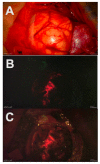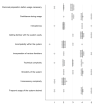Evaluation of a Novel Three-Dimensional Robotic Digital Microscope (Aeos) in Neurosurgery
- PMID: 34503083
- PMCID: PMC8428371
- DOI: 10.3390/cancers13174273
Evaluation of a Novel Three-Dimensional Robotic Digital Microscope (Aeos) in Neurosurgery
Abstract
Objective: Current literature debates the role of newly developed three-dimensional (3D) Exoscopes in the daily routine of neurosurgical practice. So far, only a small number of cadaver lab studies or case reports have examined the novel Aesculap Aeos Three-Dimensional Robotic Digital Microscope. This study aims to evaluate the grade of satisfaction and intraoperative handling of this novel system in neurosurgery.
Methods: Nineteen neurosurgical procedures (12 cranial, 6 spinal and 1 peripheral nerve) performed over 9 weeks using the Aeos were analyzed. Ten neurosurgeons of varying levels of training were included after undergoing device instruction and training. Following every surgery, a questionnaire consisting of 43 items concerning intraoperative handling was completed. The questionnaires were analyzed using descriptive statistics.
Results: No intraoperative complications occurred. Surgical satisfaction was ranked high (78.95%). In total, 84.21% evaluated surgical ergonomics as satisfactory, while 78.95% of the surgeons would like to use this system frequently. Image quality, independent working zoom function and depth of field were perceived as suboptimal by several neurosurgeons.
Conclusion: The use of Aeos is feasible and safe in microsurgical procedures, and surgical satisfaction was ranked high among most neurosurgeons in our study. The system might offer advanced ergonomic conditions in comparison to conventional ocular-based microscopes.
Keywords: Exoscope; ergonomics; microsurgery; operating microscope.
Conflict of interest statement
J.K. received honoraria from Aesculap AG, Brainlab AG, Carl Zeiss Meditec AG and CSL Behring GmbH. All other authors certify that they have no involvement in and no affiliations with any organization or entity with any financial interest (such as membership, educational grants, honoraria, consultancies, employment, stock ownership or other equity interests; patent-licensing or expert testimony agreements), or non-financial interests (such as professional or personal relationships, affiliations, knowledge or beliefs) concerning the subject matter or materials in this manuscript.
Figures










References
-
- Khalessi A.A., Rahme R., Rennert R.C., Borgas P., Steinberg J.A., White T.G., Santiago-Dieppa D.R., Boockvar J.A., Hatefi D., Pannell J.S. First-in-man clinical experience using a high-definition 3-dimensional exoscope system for microneurosurgery. Oper. Neurosurg. 2019;16:717–725. doi: 10.1093/ons/opy320. - DOI - PubMed
-
- Murai Y., Sato S., Yui K., Morimoto D., Ozeki T., Yamaguchi M., Tateyama K., Nozaki T., Tahara S., Yamaguchi F. Preliminary clinical microneurosurgical experience with the 4K3-dimensional microvideoscope (ORBEYE) system for microneurological surgery: Observation study. Oper. Neurosurg. 2019;16:707–716. doi: 10.1093/ons/opy277. - DOI - PubMed
LinkOut - more resources
Full Text Sources
Miscellaneous

